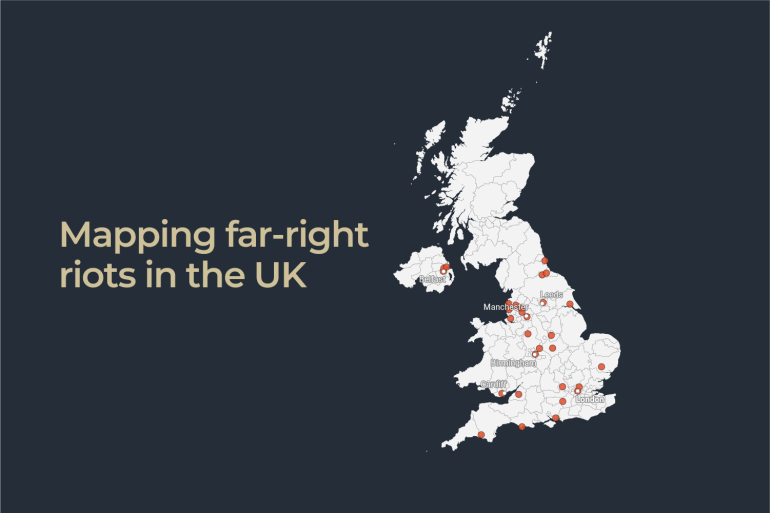Mapping far-right riots in the UK
More than 400 people have been arrested across the UK following a week of rioting and vandalism targeting Muslims, migrants and minorities.
[Al Jazeera]By AJLabs and Al Jazeera StaffPublished On 7 Aug 20247 Aug 2024
Rioters have attacked people, shops, cars and public spaces as far-right violence sweeps across the United Kingdom.
Prime Minister Keir Starmer has decried “far-right thuggery”.
Keep reading
list of 4 itemsend of list
But members of Muslim community and activists have accused politicians, including the governing Labour party, of downplaying the levels of racism and Islamophobia taking place. They also say politicians and some media outlets are to blame for railing against migration for years.
What started the riots?
Disinformation on social media is an immediate factor.
The July 29 killing of three young girls in a knife attack on a Taylor Swift-themed dance and yoga workshop in the northern English town of Southport shocked the UK. A 17-year-old suspect, Axel Rudakubana, was arrested in connection with the worst violence in the UK in a decade.
But false information on social media about the suspect’s origins spread like wildfire with some falsely naming him as a Muslim and migrant. The name “Ali al-Shakati”, with no official source, was shared.
People blow bubbles at the ‘Kisses to Heaven’ tribute to the victims of a knife attack, in Southport, UK [Kirsten Donovan/Reuters]
Even after the suspect was named as Rudakubana, a British-born teenager who is neither a Muslim nor a migrant, agitators continued to decry immigration and Muslims.
In the days following the attack in Southport, protests led by far-right groups escalated into clashes with police in multiple towns, as a wave of unrest saw rioters targeting mosques and businesses owned by the minority community and hotels housing asylum seekers.
Who is behind the riots?
Many of the rioters back the far right, police have said.
Well-known far-right figures such as Tommy Robinson, whose real name is Stephen Yaxley-Lennon, and the influencer Andrew Tate have been posting at pace, stirring up hatred online.
Tate said in a video on X that an “undocumented migrant” who had “arrived on a boat” had attacked the girls in Southport.
Robinson told his 800,000 followers on X that there was “more evidence to suggest Islam is a mental health issue rather than a religion of peace”.
Reform UK leader Nigel Farage is said to have fuelled tensions by questioning whether police were being truthful about Southport’s attack not being “terror-related”.
Where have riots spread in the UK?
Riots have swept across most of the UK, including in Wales and Northern Ireland, however, the majority of unrest has been in English cities and towns.
Some of the locations include: Aldershot, Belfast, Birmingham, Blackburn, Blackpool, Bolton, Bristol, Cardiff, Darlington, Hartlepool, High Wycombe, Hull, Leeds, Leicester, Liverpool, London, Manchester, Middlesbrough, Nottingham, Plymouth, Portsmouth, Preston, Rotherham, Southport, Stoke-on-Trent, Sunderland, Tamworth and Weymouth.
How many people have been arrested?
More than 400 people have been arrested since the violence began, 100 of whom have already been charged.
According to London Metropolitan Police, 111 people were arrested in central London on Wednesday following a demonstration in Whitehall.
In other places such as Middlesbrough, in northern England, about 43 people were arrested on Monday, said Cleveland police. At least 29 people had been arrested in Hull so far, according to Humberside police.
Flames burn as demonstrators take part in an anti-immigration protest, in Rotherham, UK, August 4, 2024 [Hollie Adams/Reuters]
Why are Muslims, immigrants, and other minority groups being targeted?
Muslims have borne the brunt of the attacks, but Black Britons and immigrants have also been targeted.
The feeling among many is that everyone in the country who is not white could be targeted.
In Stoke-on-Trent, a mosque was vandalised earlier in the week as part of the protest that turned violent on Saturday.
The causes of the riots are complex. There are explanations here and here. The Southport tragedy appears to have provided the far right with a “reason” to riot, but there are longer-term factors at play, such as the anti-migrant narratives adopted by several leading politicians.
Some British media outlets are asking if the far-right rioters have legitimate concerns about immigration.
A recent YouGov poll suggests 8 percent of Britons sympathise with the rioters.
What’s next?
Police and officials are telling the public that perpetrators of violence and abuse will be punished. Meanwhile, ethnic minority and migrant communities are becoming more fearful.
In a recent news conference, South Yorkshire Police’s Assistant Chief Constable Lindsey Butterfield stated, “If you were there, we will find you and you will be held accountable for yesterday’s violence.”
Veteran Labour politician Diane Abbott said on X, “Nationwide anti-immigrant riots on a scale never seen before. Threatening life, property and our police force. We need to recall Parliament.”
On Wednesday, police say 100 more far-right gatherings could take place. They have deployed thousands of officers to avert possible attacks on immigration solicitors and refugee centres.
